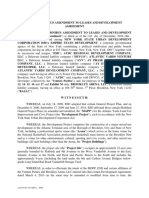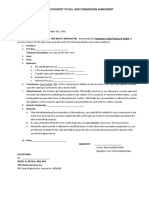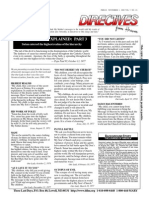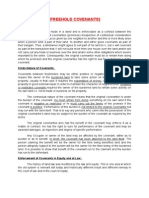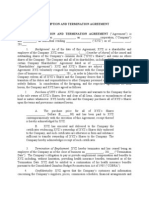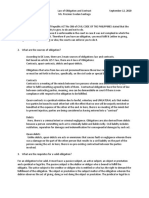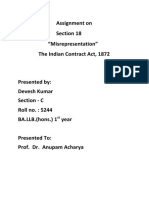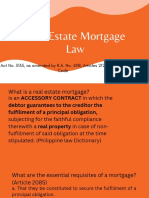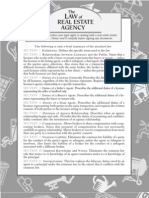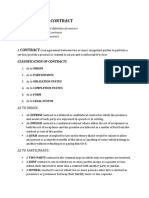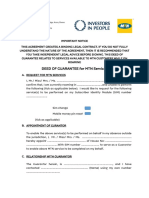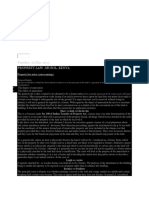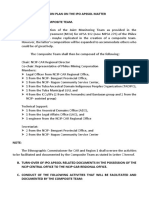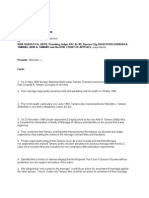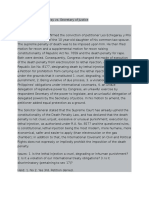Concept of Land
Concept of Land
Uploaded by
Christine FongCopyright:
Available Formats
Concept of Land
Concept of Land
Uploaded by
Christine FongOriginal Title
Copyright
Available Formats
Share this document
Did you find this document useful?
Is this content inappropriate?
Copyright:
Available Formats
Concept of Land
Concept of Land
Uploaded by
Christine FongCopyright:
Available Formats
Concept of Land
Conceptual background: Five Keys to Land Law Birks
[W]e are of the view that the proposition that a landowner may excavate his land with impunity, sending his neighbour's building and everything in it crashing to the ground, is a proposition inimical to a society which respects each citizen's property rights, and we cannot assent to it [The law] must instead take root in the terra firma of the principles of reciprocity and mutual respect for each other's property We believe that the true legal justification for the right of support is the legal principle encapsulated in the Latin maxim sic utere tuo ut alienum non laedas, which translates into English to: use your own property in such a manner as not to injure that of another. The importance of that principle is compounded in Singapore in view of our land use pattern, whereby all land available for commercial, industrial or residential purposes is used to a high intensity. The damage that might be caused if landowners were lackadaisical in their excavation works could be astronomical, not to mention the cost in human lives or injury to property.
Xpress Print Pte Ltd v Monocrafts Pte Ltd [2000] 3 SLR 545 at [37], [47]-[48] per Yong Pung How CJ DEFINITION OF LAND STATUTORY DEFINITIONS AVAILABLE
Land is treated differently from other assets. What one has is an estate in land. An important thing regarding an estate is the time factor. It is an interest in land measured by time. No one in a common law country owns land. The Crown or the Republic holds all land and if the State needs the land, all it has to do is follow the rules under the relevant statute. E.g. the Land Acquisition Act. The State does not exert its title; it follows the procedures under the Act. All land is derived from the State. No one owns land. All one can own is an estate. This is an interest in land measured by time. There is also a doctrine of tenure. This is the terms/conditions on which the land is held. This is difficult to see nowadays. Where it can be seen is in the lease. Ten in Latin refers to the act of holding.
Definitions There are various statutes that give us definitions of the word land. CLPA s 2: Includes land freehold and leasehold, or of whatever tenure and tenements and hereditaments, corporeal or incorporeal, and houses and other buildings and also an undivided share in land. LTA s 4: Land means (a) the surface of any defined parcel of the earth, all substances there under and so much of the column of airspace above the surface whether or not held apart from the surface as is reasonably necessary for the proprietors use and enjoyment, and includes any estate or interest therein and all vegetation growing thereon and structures affixed thereto.
PHYSICAL EXTENT OF LAND (in a 3-dimensional sense) Latin maxim: He who owns land owns everything above it reaching up to the skies and reaching down to the centre of the earth: reflects that land includes the trees, buildings, minerals and the airspace above it. This applies in Singapore through the Second Charter of Justice. Not a workable idea; this is now subject to: aviation rights land use planning controls Gold and silver belonging to the crown traditionally other statutes. Land Title (Strata) Act Strata allow for horizontal division of airspace Refers to so much of the column of airspace above the surface, whether or not held apart from the surface, as is reasonably necessary for the proprietors use and enjoyment LTSA introduced in 1967 to enable a purchaser to be registered as proprietor for any defined space, including airspace. In the past, owners of flats in Singapore were granted long leases, thereby making them coowners of a freehold, rather than outright owners as they are now. How far above and below the solum can someone claim rights? The higher strata of airspace is the commons, that belong to everybody and nobody. Aerial Photography: Bernstein v. Skyviews & General Ltd Bernstein was a TV producer and Skyviews was an aerial photography company. Bernstein was not happy when someone from Skyviews turned up offering him a photograph of his home. He claimed that Skyviews, inter alia, had intruded into his airspace. Held that in this case, the plane that carried out the photography was in fact in the upper stratum of airspace, outide the lower stratum which could reaosnably be called that of the proprietor of the solum. The plane was in the commons, open for exploitation and use of the public. Contra United States v. Causby, per Justice Douglas The landowner has got to have some rights over the superjacent airspace above his/her solum because if that were not so, he/she would not be able to do anything on his/her solum without committing a trespass. Where is the borderline then between the airspace that is subject to legitimate ownership and the airspace that is not? Kevin Gray: generally about 200m above ground Need to make a pragmatic distinction between higher and lower strata of airspace. Ones ownership rights extends only to the lower stratum. In Singapore, the strata is that which is reasonably necessary for
the enjoyment and use of the land. Parcel of land includes subterranean land as well Kim Beng Kee Pte Ltd v. Kosion Enterprise (S) Pte Ltd A purchaser entered into a contract to buy a piece of land,. He then found out that there was going to be a viaduct built that crossed over the corner of the land. There would thus be an intrusion of the airspace of the land. Held that within the lower stratum of airspace, the landowner had a right of ownership to everthing within that airspace with the result that the viaduct is going to be an intrusion into the property that was being sold. The purchaser was thus entitled in seeking to withdraw from the contract of sale because that which he had contracted to buy could not be delivered Court said viaduct was a derogation of the rights that came with the land
What is considered part of the land? Latin Maxim: Quid quid plantatur solo, solo credit. That which is attached to the land is part of the land. The threefold classification for determining whether objects that are brought into close association with the land are part of the land - Elitestone Ltd v. Morris: 1) Chattels 2) Fixtures 3) Constructions which are part and parcel of the land The question is essentially whether an object that is attached to the land is part of the land. Constructions which are part and parcel of the land A conveyance of land is deemed to include buildings, erections, fixtures, commons, hedges, ditches, fences Conveyancing and Law of Property Act, s 6 Statute s. 6 CLPA: deemed to include Buildings Erections Fixtures Commons, hedges, ditches fences What constitutes a building? At common law, buildings are regarded as part of the land as a general rule Pretty straight-forward if building is permanently fixed to the land Only gets complicated when the house is not annexed to the soil (Elitestone Ltd v. Morris) Question was whether a house resting on its own weight on concrete
pillars, which were built onto the ground (but not annexed to the soil) was part of the land or a mere chattel House of Lords said that for houses, the important test was the uses and purposes for which they were erected and designted. [A] house which is constructed in such a way that it cannot be removed at all, save by destruction, cannot have been intended to remain as a chattel. It must have been intended to form part of the realty This question of purpose was an objective, not subjective one; i.e. the purpose which the object serves, not the intention of the person who put it there There is one exception based on local custom: Kiah bte Hanapiah v. Som per Murray-Ansley CJ there is a settled custom in this country (Malaya) that houses of this type are regarded as personalty in which ownership may be separate from ownership of the soil. I think effect should be given to this custom to the exclusion of the English law of fixtures However, this exception should only apply where there is proved custom Chua Sai Ngoh v Beh Ai Meng: specific to Malay stilt houses only; does not include a plank-walled house on concrete land. Contra Kwek Kim Hock v Ong Boon Siong per Taylor J The building in issue was a plank-walled house on a concrete floor. Held that the custom of separate ownership of land and building is a common incident in the country districts of Malaya and is a well-established variation from the principle of English law that a building becomes the property of the owner of the land. However, while it seems to be accepted that a custom exists in respect of Malay type houses resting on stilts, the question of zinc roofed, plank-walled structures on concrete floors is not clearly established. Taylor J in this case merely stated that there was such a custom, without more. The existence of such a custom has been flatly denied by Thomson J in Chua Sai Ngoh, and the correctness of Kwek is doubted.
Fixtures v. Chattels The distinction between fixtures and chattels is crucial in several situations: (i) Vendor v. Purchaser. When you sell a piece of land, fixtures pass to the purchaser e.g: Whether a statue in the garden of a plot of land purchased belongs to purchaser or vendor. (ii) Lessor v. Lessee (slightly more complicated, see below) Especially in a landlord-tenant relationship; at the end of a tenancy, do fixtures installed by a tenant pass to the landlord? (iii) Mortagee v. Mortgagor Security taken by lendor of money would be enhanced by fixtures on the land.
E.g. Whether chattel placed in the land by mortgagor can be sold by mortgagee when he exercises his rights. (iv) Property tax The question of what constitutes the property (fixtures) is important because property tax is levied on the property (ya). Application: Starting point: CLPA s.6 conveyance includes fixtures s. 4 LTA land includes structures affixed Therefore: fixtures accede to the realty are considered part of the land; Chattels do not Legal distinction that is made on the nature of an object attached to the land Whether something is a fixture or chattel Locus Classicus: Holland v Hodgson An article which is affixed to the land even slightly is to be considered part of the land, unless the circumstances are such as to show that it was all along to continue as a chattel, the onus lying on those who contend it is a chattel 2-limb test [Holland v Hodgson per Blackburn J; affirmed in Elitestone v Morris] (i) (ii) The (physical) manner & degree of annexation The object or intent of annexation.
The physical degree of annexation test History: Used to be heavily determinative, but later cases have shown that the object of annexation overrides the physical degree of annexation test Use: Raises a rebuttable presumption; Still influences result determines the burden of proof The Test Where the chattel is secured to the building by means of screws, nuts, nails & bolts, presumption is that it is part of the land, & the person who says that it remains a chattel has the burden of proof. Where the article rests on the ground by its own weight, it is prima facie a chattel unless shown it is intended to be part of the land. Holland v Hodgson Fixture: Manner of annexation of looms was by way of nails; the looms did not rest on the floor by their own weight. They were attached to the floor in that manner by the owner of the mill. If a structure can only be enjoyed in situ, and could not be removed in whole or in sections to another site, there is a strong inference that it should form part of the realty at that site & thus
cease to be a chattel. When the article in question is no further attached to the land than by its own weight it is generally considered to be a mere chattel.
Objective purpose of annexation Question of physical annexation does not answer the question completely so there is a need to examine the objective purpose of annexation This is an objective test The question of purpose centres on the purpose for which the object is serving, rather than the purpose intended by the person who put it there. The purpose test can override the presumption raised by the physical annexation test Question to ask is whether the purpose is to enhance the enjoyment of the chattel or the improvement of the realty Distinction is to be drawn between: [Hellawell v Eastwood per Parke B] Chattel attached for a temporary purpose and the better enjoyment of it as a chattel [chattel] Chattel attached for the permanent and substantial improvement of the land [fixture] Where presumption that something is prima facie a chattel is rebutted Part of the architectural design DEyncourt v. Gregory Prima facie chattel according to the physical test A collection of marble statues which rested simply on their own weight Held to be fixtures the underlying motivation was that they should accede to the reality, they were part of the architectural design intended to meld with the realty and become part of the land Escalators resting on own weight where set in specially constructed parts of the building for them People's Park Chinatown Development Pte Ltd v Schindler Lifts (S) Pte Ltd Prima facie chattel: Escalators rested on their own weight, were not bolted on Escalators were set in specific parts of the building that had been specially constructed for them Possible distinguishing fact! Escalators were not functioning/running yet Held to be fixtures Although they rested on their own weight, the underlying purpose was that they were to become an inseparable part of the building Heavy objects Chief Assessor & Comptroller of Property Tax v. Van Ommeren Terminal (S) Pte Ltd Prima facie chattel
Storage tanks rested on their own weights in sand pits Held they were fixtures. Even though they rested on their own weight, the storage tanks were placed on the property to improve or promote the enjoyment of the land rather than of the chattels themselves. Judge did not think any significance should be attached to the lack of bolting or attachment to the land they were heavy objects Where prima facie presumption of fixture was rebutted: Proportionality between value of chattel and quantum of interest in land may be a factor Spyer v. Phillipson A tenant for a term of 21 years had attached antique panelling and ornamental chimney pieces to the building by means of screws and nails. On the death of the tenant a dispute arose as to whether the panelling and the chimney pieces could be removed by the personal representatives of the deceased tenant. The court held that it was not likely that a person with a limited interest in the land would put in such valuable chattels with the objective of giving them away to the lessor. Note: where the person annexing the chattel is the owner of the freehold it would seem that the courts assume that the intention is to benefit the land
Plants accede to the land? Potted v. growing in garden soil S. 4 LTA vegetation growing thereon Therefore where plants are growing in garden soil run with then land by virtue of s. 4 Where potted, or otherwise not growing in soil [maybe climbing plants]: Apply Holland v Hodgson? Tenants Fixtures and Landlords Fixtures Rationale: The rule of fixtures seems to be very harsh where the person concerned annexing the chattels to the land had a limited interest in the land. Hence the development of the doctrine of tenants fixtures A concession made to the tenant Tenants fixtures legal classification: notwithstanding that certain chattels have become fixtures, they can be removed by the tenant during the continuance of the term or within a reasonable time after its expiration What is regarded as tenants fixtures: Where a tenant annexed machinery that was necessary for his trade which was carried on the premises, or where he had put in chattels which were ornamental e.g. chimney pieces Spyer v Philipson
tapestry Leigh v Taylor panelling Where not removed However, if they are not removed within the term, or soon after its expiration, they become landlords fixtures. Goh Chong Hin v. The Consolidated Malay Rubber Estates Ltd. Application: Riduan Bin Yusof v Khng Thian Huat (No. 2) Facts: Tenant took over commercial premises for use as a kindergarten. At the end of the tenancy, tenant said he was entitled to take away the rather expensive facilities he had installed for fire protection Court of Appeal agreed with the tenant Classic case of tenants fixtures Inconceivable that parties could have intended at the start of the tenancy to let all the expensive equipment remain in situ, effectively allowing the landlord to reap a windfall Where tenant still has right of removal i.e. within the tenancy term, and allowance for a reasonable time after its expiration he has property in the fixtures BP Refinery Singapore Pte Ltd v. Amazon Group Ltd Dispute over breach of contract. BP as lessee had erected on land a plant and equipment for their business of oil refining consisted of huge structures. Entered into an agreement to sell the equipment to Amazon. Amazon failed to keep up with installments. In its defence, alleged that BP had no title of the equipment since they were fixtures and acceded to the realty Held The equipment which BP Refinery, the lessee of the land, had erected on the land for their business were fixtures. Tenant had property in the fixture during the duration of the tenancy However they were tenants fixtures, BP refinery had the power to remove them during the term of the lease or within a reasoanble time after the expiry of the lease. It is only when the tenants right of removal was gone that it can be said that the landowner is also the owner of the fixtures.
You might also like
- Wisconsin Realtors Association Residential Rental ContractDocument2 pagesWisconsin Realtors Association Residential Rental ContractSamuel ZhuNo ratings yet
- Sellers RRRR#2Document2 pagesSellers RRRR#2Enrique GuevaraNo ratings yet
- Ownership V Possession 2Document8 pagesOwnership V Possession 2SubsectionNo ratings yet
- Purchase Agreement @HackersFather66Document3 pagesPurchase Agreement @HackersFather66Lucky DavidNo ratings yet
- Fourth Omnibus Amendment To Leases and Development Agreement, Dec. 21, 2018, Atlantic Yards/Pacific ParkDocument94 pagesFourth Omnibus Amendment To Leases and Development Agreement, Dec. 21, 2018, Atlantic Yards/Pacific ParkNorman OderNo ratings yet
- Relocation SettlementDocument5 pagesRelocation Settlementrich chast100% (1)
- Land As "Property"Document29 pagesLand As "Property"Natasha DenningtonNo ratings yet
- Authority To Sell LetterDocument1 pageAuthority To Sell LetterDanica RafolsNo ratings yet
- PD 1529 Assurane Fund CasesDocument52 pagesPD 1529 Assurane Fund CasesGracey Sagario Dela TorreNo ratings yet
- This NationDocument7 pagesThis NationMarc_SemNo ratings yet
- Obedience To God: Third Secret Explained: Part 3Document2 pagesObedience To God: Third Secret Explained: Part 3maria1grazia1mazzaNo ratings yet
- Tenancy Act 2004Document148 pagesTenancy Act 2004oconnb00No ratings yet
- How To Receiver Your Government Retirement Checks On TimeDocument7 pagesHow To Receiver Your Government Retirement Checks On TimeAllen Carlton Jr.No ratings yet
- Inalienable Right To Trial by Jury Act 2010 No. of 2009Document4 pagesInalienable Right To Trial by Jury Act 2010 No. of 2009workcovervictim8242No ratings yet
- Freehold Covenants ADocument3 pagesFreehold Covenants Aapi-234400353No ratings yet
- Transfer of Property - IDocument9 pagesTransfer of Property - Isuchandrika nathNo ratings yet
- Title 5 RepresentationDocument4 pagesTitle 5 RepresentationMakoy MolinaNo ratings yet
- Except Claims Which Were Noted at The Time of Registration, in The Certificate, or Which May AriseDocument11 pagesExcept Claims Which Were Noted at The Time of Registration, in The Certificate, or Which May Arisevelasquez0731No ratings yet
- Effect of Persons in Possession of Real Estate Other Than The Owner/Vendor On A Buyer's Status As A Bona Fide Purchaser - Arizona State Court CasesDocument32 pagesEffect of Persons in Possession of Real Estate Other Than The Owner/Vendor On A Buyer's Status As A Bona Fide Purchaser - Arizona State Court Casesrichdebt100% (1)
- Redemption and Termination AgreementDocument4 pagesRedemption and Termination Agreementpeaser0712No ratings yet
- Timeshare Law 514EDocument28 pagesTimeshare Law 514Eishu01200101No ratings yet
- Estate & Donors TaxDocument31 pagesEstate & Donors TaxMea De San AndresNo ratings yet
- Concept of LandDocument4 pagesConcept of LandOtu-ekong Bassey Ekong100% (1)
- Petitioner Vs Vs Respondent Leo Luis P. Mendoza For Petitioner. Robiso & Reyes For RespondentDocument10 pagesPetitioner Vs Vs Respondent Leo Luis P. Mendoza For Petitioner. Robiso & Reyes For RespondentBiancaDiwaraNo ratings yet
- Exclusive Right To Sell Listing AgreementDocument9 pagesExclusive Right To Sell Listing Agreementj4dprints deocampoNo ratings yet
- Alliance For Jobs and The EconomyDocument13 pagesAlliance For Jobs and The EconomyJohn ArchibaldNo ratings yet
- Estate Tax RatesDocument5 pagesEstate Tax RatesJohn Carlos WeeNo ratings yet
- Assignment - The Law On Obligations (DONE)Document6 pagesAssignment - The Law On Obligations (DONE)William DC RiveraNo ratings yet
- REM ProcessDocument11 pagesREM ProcessAAPHBRSNo ratings yet
- Assignment On Section 18 "Misrepresentation" The Indian Contract Act, 1872Document15 pagesAssignment On Section 18 "Misrepresentation" The Indian Contract Act, 1872DeepakGupta100% (1)
- Real Estate Mortgage Law: Act No. 3135, As Amended by R.A. No. 4118, Articles 2124-213 Civil CodeDocument15 pagesReal Estate Mortgage Law: Act No. 3135, As Amended by R.A. No. 4118, Articles 2124-213 Civil CodeAlexis dimagiba100% (1)
- Lease Takeover Notification FormDocument1 pageLease Takeover Notification FormNithish SajiNo ratings yet
- Law of Real Estate Agency PamphletDocument7 pagesLaw of Real Estate Agency PamphletSusan Marcoe DraperNo ratings yet
- Acquiring Title by Adverse Possession - Oregon Lawyer OnlineDocument2 pagesAcquiring Title by Adverse Possession - Oregon Lawyer OnlineJohnny LolNo ratings yet
- The Depositories Act 1996Document3 pagesThe Depositories Act 1996jineshshah1991No ratings yet
- Assignment #6Document3 pagesAssignment #6Lenmariel GallegoNo ratings yet
- Legal Aspect of MortgageDocument4 pagesLegal Aspect of MortgageIVAN CHRISTOPHER AGUSTINNo ratings yet
- Common Sense Thomas Paine February 14, 1776Document25 pagesCommon Sense Thomas Paine February 14, 1776KregenerNo ratings yet
- Land Law Notes Year 2Document11 pagesLand Law Notes Year 2bhavika chandnaniNo ratings yet
- Instruction For New AccountDocument7 pagesInstruction For New AccountVasishtha TeeluckdharryNo ratings yet
- Section 106 Leases in Absence of ContractDocument6 pagesSection 106 Leases in Absence of Contract18212 NEELESH CHANDRANo ratings yet
- Cooperation Agreement RentDocument11 pagesCooperation Agreement RentEIS LatviaNo ratings yet
- Madison Dismissal From City of MadisonDocument5 pagesMadison Dismissal From City of MadisonWAFF 48 NewsNo ratings yet
- Land Title 0002Document1 pageLand Title 0002Dan Jeric Arcega Rustia100% (1)
- Is and Elector A Land OwnerDocument7 pagesIs and Elector A Land OwnerThom Lee ChapmanNo ratings yet
- FIN 331 Chapter 3Document41 pagesFIN 331 Chapter 3Balu Mahendra SusarlaNo ratings yet
- Give Yourself CreditDocument5 pagesGive Yourself CreditJesy D Wheeler100% (1)
- Law On PledgeDocument7 pagesLaw On PledgeLesterNo ratings yet
- Contract To SellDocument3 pagesContract To SellIan GermanNo ratings yet
- ELEMENTS OF A CONTRACT - WordDocument3 pagesELEMENTS OF A CONTRACT - WordcheskaNo ratings yet
- Surplus Cash Note: Note Must Be On or After The Maturity Date of The Note.)Document3 pagesSurplus Cash Note: Note Must Be On or After The Maturity Date of The Note.)PAW F McCOY100% (1)
- Attachments in Execution ProceedingsDocument6 pagesAttachments in Execution Proceedingssubbarao_rayavarapuNo ratings yet
- Mortgage Redemption StatementsDocument4 pagesMortgage Redemption StatementsThe Lone GunmanNo ratings yet
- Deed of Guarantee For MTN ServicesDocument2 pagesDeed of Guarantee For MTN Servicesnanayaw asareNo ratings yet
- Accommodation Party NOTESDocument1 pageAccommodation Party NOTESMaria100% (1)
- Assignment What Is The Contract of Pledge? What Are The Requisites of A Contract of Pledge?Document9 pagesAssignment What Is The Contract of Pledge? What Are The Requisites of A Contract of Pledge?Arvin RobertNo ratings yet
- Notes On Deed of Sale of Motor VehicleDocument1 pageNotes On Deed of Sale of Motor VehicleEllen Glae DaquipilNo ratings yet
- Latin Maxim Quicquidplantatorsolosolocedit'Document5 pagesLatin Maxim Quicquidplantatorsolosolocedit'Sudarshani SumanasenaNo ratings yet
- Real Property - Lecture 1Document33 pagesReal Property - Lecture 1Toniann LawrenceNo ratings yet
- The Knowledge Tree (Law Notes) : Tuesday, 19 May 2015 Property Law - Musol, KenyaDocument20 pagesThe Knowledge Tree (Law Notes) : Tuesday, 19 May 2015 Property Law - Musol, KenyaMercy NamboNo ratings yet
- Lease Agreement of Plaza SideDocument1 pageLease Agreement of Plaza SideMuhammad IsmailNo ratings yet
- STCC-RSP 2015 & Proforma PDFDocument34 pagesSTCC-RSP 2015 & Proforma PDFUpul ChandimaNo ratings yet
- Hilario v. SalvadorDocument1 pageHilario v. SalvadorBenBulacNo ratings yet
- People vs. Ocimar J. Bellosillo - August 17, 1992Document1 pagePeople vs. Ocimar J. Bellosillo - August 17, 1992Henri VasquezNo ratings yet
- Casestudy1 GuymasonDocument4 pagesCasestudy1 Guymasonapi-567045739No ratings yet
- Judicial Affidavit of Arresting Officer - PD 1866Document7 pagesJudicial Affidavit of Arresting Officer - PD 1866Karla Marie Tumulak75% (8)
- EStampa v. City Govt. of DAvaoDocument11 pagesEStampa v. City Govt. of DAvaoLeizl A. VillapandoNo ratings yet
- CrimRev Notes - Book IDocument34 pagesCrimRev Notes - Book IAgnes Bianca MendozaNo ratings yet
- Pallav Sheth Vs Custodian and Ors 10082001 SCs000437COM332027Document17 pagesPallav Sheth Vs Custodian and Ors 10082001 SCs000437COM332027A. L. JainNo ratings yet
- The Maharashtra Recognition of Trade Unions and Prevention of Unfair Labour Practices ActDocument29 pagesThe Maharashtra Recognition of Trade Unions and Prevention of Unfair Labour Practices ActNikita DadlaniNo ratings yet
- PP v. Orande DigestDocument2 pagesPP v. Orande DigestCharisse ToledoNo ratings yet
- Action Plan On The IPO-APSSOL MatterDocument2 pagesAction Plan On The IPO-APSSOL MatterSeverino LumiquedNo ratings yet
- RA 9165 Cases PDFDocument49 pagesRA 9165 Cases PDFCesyl Patricia BallesterosNo ratings yet
- Scentsy v. Kellytoy Worldwide - ComplaintDocument41 pagesScentsy v. Kellytoy Worldwide - ComplaintSarah BursteinNo ratings yet
- Tamano Vs OrtizDocument4 pagesTamano Vs OrtizNath AntonioNo ratings yet
- Echegaray Vs Secretary of JusticeDocument4 pagesEchegaray Vs Secretary of JusticeRaks SanglitanNo ratings yet
- Ching vs. Goyanko, Jr. (G.R. No. 165879)Document11 pagesChing vs. Goyanko, Jr. (G.R. No. 165879)aitoomuchtvNo ratings yet
- Bayanin vs. Philippine National Bank, G.R. No. 240355, February 27, 2023Document13 pagesBayanin vs. Philippine National Bank, G.R. No. 240355, February 27, 20238tvtynvjyzNo ratings yet
- Defective ContractsDocument9 pagesDefective ContractsQueensha GoNo ratings yet
- Ju Je Offer LetterDocument3 pagesJu Je Offer LetterPramod ShendigeNo ratings yet
- Alternative Dispute Resolution ReviewerDocument15 pagesAlternative Dispute Resolution ReviewerwhatrichNo ratings yet
- Assignment 2Document5 pagesAssignment 2Laurance Namukamba100% (1)
- Stenography NotesDocument5 pagesStenography NotesjennylynneNo ratings yet
- DISINHERITANCEDocument15 pagesDISINHERITANCESachieCasimiroNo ratings yet
- Andrew Steele v. United States, 362 F.2d 536, 10th Cir. (1966)Document3 pagesAndrew Steele v. United States, 362 F.2d 536, 10th Cir. (1966)Scribd Government DocsNo ratings yet
- GoJo Industries v. Dr. FreshDocument4 pagesGoJo Industries v. Dr. FreshPriorSmartNo ratings yet
- 77 - Wylie v. Rarang - State Immunity From SuitDocument2 pages77 - Wylie v. Rarang - State Immunity From SuitJuvial Guevarra BostonNo ratings yet
- LegalEthicsDigest - People of The Philippines Vs Remigio Estebia, GR L-26868, (27 Feb. 1969)Document2 pagesLegalEthicsDigest - People of The Philippines Vs Remigio Estebia, GR L-26868, (27 Feb. 1969)Lu Cas100% (3)
- BJDC v. LanuzoDocument4 pagesBJDC v. LanuzoKaren Joy MasapolNo ratings yet
- CRIM PRO Lesson 1Document77 pagesCRIM PRO Lesson 1Henrick YsonNo ratings yet




